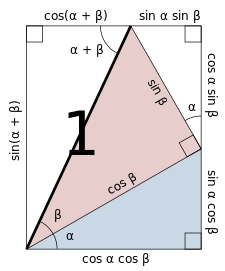User:Greenbreen/incubator
Trigonometric functions play an important role in calculus. Here we review some basic facts about these functions.
Basic trigonometric functions
[edit | edit source]The basic trigonometric functions are the sine, cosine and tangent functions. In mathematical expressions, these are represented as , and respectively. These functions relate the angles in a right triangle to various ratios of the lengths of the triangle's sides. You may recall the mnemonic SOH-CAH-TOA, which helps the student remember these relationships. Refer to the figure below. is the angle of interest, is the length of the side of the triangle opposite the angle, is the length of the side of the triangle adjacent to the angle, and is the length of the hypotenuse. The mnemonic tells us that , , and .
Measuring angles
[edit | edit source]In everyday life it is common to measure angles in degrees, where there are 360 degrees in a circle. In mathematics it is often convenient to use a different measure of angles, the radian. There are radians in a circle. Why is the radian used in math? It turns out that the radian is a natural measure of circles. Consider the circle in the figure below. is the radius, is an angle with vertex at the center of the circle, and is the arc of the circle subtended by the angle. By using radians as the measure for the equation holds. Certain operations we will study in calculus are simplified by using radians as the measure of angles.
Suppose you want to convert between radians and degrees. There are 180 degrees and radians in a half circle. Using the ratio of degrees to radians or radians to degrees in a half circle gives us a scaling factor to convert from radians to degrees or degrees to radians, respectively.
The unit circle
[edit | edit source]A circle with radius 1 is called a unit circle. Imagine a circle with center at the origin of a Cartesian coordinate system, and imagine a line segment drawn from the center to an arbitrary point on the circle. Call this point . Suppose we know the angle, with vertex at the origin, one ray lying on the positive x-axis and one ray passing through . We would like to know the coordinates of in terms of . Consider the triangle one point at the origin, one at , and one on the point of intersection of the x-axis and a vertical line drawn through . The triangle so formed is a right triangle since the angle formed at the last point is formed from the intersection of perpendicular lines. We can use trigonometry to find the coordinates of . is the length of the leg adjacent to . We know that , where is the length of the adjacent leg and is the length of the hypotenuse. and , being the radius of the unit circle, is just 1. Thus, . A similar argument shows that so that .
Other trigonometric functions
[edit | edit source]In addition to the basic trigonometric functions we have covered so far, there are three other trigonometric functions that we will see in our study of calculus, namely, the secant, cosecant, and cotangent functions, represented mathematically as , , and , respectively. These functions are simply the multiplicative inverses of the cosine, sine, and tangent functions, respectively.
Trigonometric identities
[edit | edit source]From the definitions of , , and and , one can see that . Likewise, .
We can derive some useful identities using the definitions of the trigonometric functions together with the Pythagorean theorem. Recall that, given a right triangle having sides of length and and hypotenuse of length , that . Suppose the angle opposite the leg with length is . Then and . Then .
If we divide the above equation by and replace the resulting expressions with their multiplicative inverses where applicable, we immediately derive another useful identity, namely
.
Deriving the angle addition formulae for sine and cosine
[edit | edit source]








































